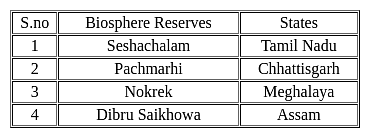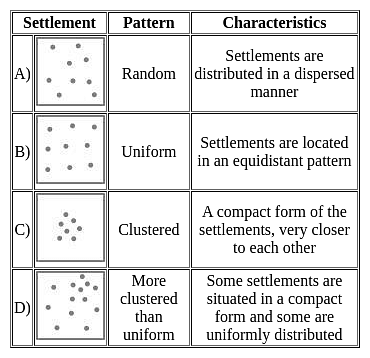APSET Paper 2 Mock Test - 5 (Geography) - AP TET MCQ
30 Questions MCQ Test - APSET Paper 2 Mock Test - 5 (Geography)
Given below are two statements, one is labelled as Assertion (A) and the other is labelled as Reason (R). Read the statements and choose the correct answer using the code given below.
Assertion (A) :Nearest Neighbor Analysis measures the spread or distribution of something over geographical space
Reason (R) : The Rn value determines the randomness of the given settlements.
Which one among the following States has the longest extension in north-south direction?
| 1 Crore+ students have signed up on EduRev. Have you? Download the App |
Consider the following statement of computation of composite index and state which of these are true- i. The index has indicators like development vulnerabilities, exclusions etc.
ii. They compare country performances.
iii. They are not easy to interpret.
iv. It summarizes multi-dimensional realities.
Consider the following pairs:

Which of the pairs given above are correctly matched?
(a) Monsoon break is the phenomenon which means monsoon rainfall stops for a couple of days.
(b) Western Ghats receive orographic rain during the monsoon.
(c) First rain in a place is called as monsoon burst.
(d) The El Nino current decreases the temperature of water.
Select the correct option:
Assertion- Richard Hartshorne attempts to capture difference between systematic geography and regional geography.
Reasoning- Regional geography is study of any two-dimensional area of interest.
Select the correct answer from options given below :
The general term for periods of mountain-building that include folding, faulting, magmatism and metamorphism is called as:
A potential downside of medical tourism can be:
Air is a mixture of various gases. Choose the correct statements about air from the following statements.
A. Plants take nitrogen directly from the air.
B. Green plants release oxygen gas.
C. Helium, Argon, Ozone gases are present in large quantities in the air.
D. Tiny dust particles are present in the air.
What does the volume of international trade of a country imply?
The famous “Chatham Saw Mill” is located in which among the following states / union territories of India?
Periodic change towards unusual colder side is called
a) The closed folds are formed due to mild compressive action.
b) Joints are fractures, where a significant amount of rocks are displaced.
c) Asymmetrical folds have irregular and unequal limbs.
d) The Isoclinal folds are formed when a compressive force is strong on both sides leading to parallel limbs in a fold.
Match the following:-

Choose the correct option:





















